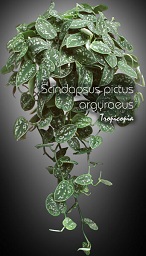Table of contents
Picta Philodendron

Latin Name: Scindapsus pictus argyraeus
Category: Hanging
Family: Araceae
Origin: Indonisia
Climate: Tropical
Growing Zones: 11-10
Care Instructions
The Picta Philodendron (Scindapsus pictus argyraeus) is a tropical plant that originates from Indonisia. This hanging plant belongs to the Araceae family and is well-suited for growing in USDA zones 11-10.
Complete Care Guide for Picta Philodendron (Scindapsus pictus argyraeus)
Watering Requirements
The Picta Philodendron, also known as Scindapsus pictus argyraeus, thrives best with a careful watering regimen. It is essential to allow the top inch of soil to dry out between waterings. Overwatering can lead to root rot, a common issue with this plant. During the growing season, typically spring and summer, you may need to water more frequently, about once a week, depending on the humidity and temperature of your environment. In the fall and winter months, reduce watering to every two weeks or when the soil feels dry to the touch. Always ensure that the pot has drainage holes to prevent water from accumulating at the bottom.
Light Conditions
Picta Philodendron prefers bright, indirect light for optimal growth. While it can tolerate lower light conditions, its growth may slow down, and the variegation may become less pronounced. Avoid placing it in direct sunlight, as this can scorch the leaves. A spot near a north or east-facing window is ideal, where it can receive filtered light. If you notice the leaves stretching towards the light source, it may be a sign that the plant needs more light. Conversely, if the leaves are turning yellow, it could indicate too much direct sunlight.
Soil Preferences
The ideal soil for Picta Philodendron is a well-draining potting mix that retains some moisture without becoming soggy. A blend of peat moss, perlite, and orchid bark works well to provide the necessary aeration and drainage. This plant benefits from a slightly acidic to neutral pH level, ideally between 6.0 and 7.0. Fertilization should be done during the growing season with a balanced, water-soluble fertilizer every 4-6 weeks. In the fall and winter, reduce or eliminate fertilization as the plant enters a dormant phase.
Pests and Diseases
Picta Philodendron is generally resilient but can be susceptible to common houseplant pests such as spider mites, mealybugs, and aphids. Regularly inspect the undersides of leaves and stems for any signs of infestation. If you notice pests, treat them promptly with insecticidal soap or neem oil. Additionally, keep an eye out for signs of fungal diseases, which can occur in overly moist conditions. Yellowing leaves or a mushy stem may indicate root rot, which requires immediate action to save the plant. Ensure proper watering practices and improve air circulation around the plant to prevent these issues.
Special Care Tips
To maintain the health and beauty of your Picta Philodendron, consider the following special care tips: Regularly wipe the leaves with a damp cloth to remove dust and enhance photosynthesis. This plant can also benefit from occasional pruning to encourage bushier growth and remove any yellowing or damaged leaves. If you want to propagate your Picta Philodendron, you can do so through stem cuttings. Simply cut a healthy stem below a node, place it in water or soil, and watch it develop roots. Lastly, be mindful of temperature; this plant prefers a warm environment, ideally between 65°F and 85°F (18°C to 29°C), and should be protected from cold drafts.








